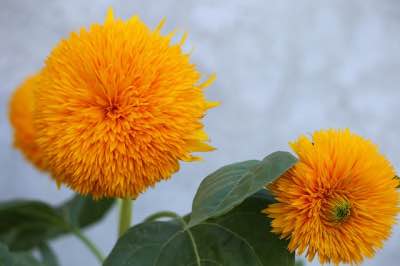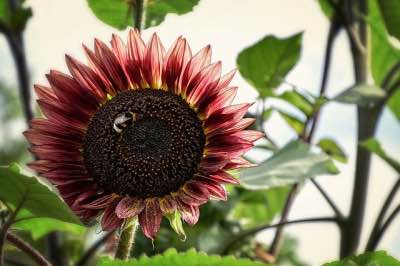Dreary winters and wet springs can bring even the cheeriest of us down. Growing plants indoors is a great way to brighten up your home, and there’s no plant that does it quite like the sunflower. Tall and beautiful, many outdoor gardens highlight their sunflowers, but we can grow them indoors too. Today, we’ll look at growing sunflowers indoors, and all the steps you’ll need to start growing these beautiful plants all year round.
Sunflower Overview
- Sunflowers love lots of light, so be prepared with a sunny location or grow lights.
- Choose dwarf varieties for indoor growing as these will grow to be smaller and easier to manage.
- Water and feed regularly doing the growing season. Water a bit more for the first 2-4 weeks after the sprouts emerge.
- Manually pollinate by using a cotton swab or paintbrush.
- At the end of the season, you can harvest seeds from your sunflower to eat or plant.
Choosing a Variety
While traditional sunflowers can grow quite large, indoors you should look at dwarf varieties. These look almost identical to typical sunflowers, they’re just a bit smaller. Many dwarf varieties stay under 3 feet tall which makes them much more manageable for indoor growing.
A couple popular varieties include:

Sunny Smile
Your classic sunflower, this dwarf variety looks almost identical to normal-sized ones but will top out at only about 2-3 feet tall.
Sunny Smile Seeds
Teddy Bear
Slightly different in appearance, the teddy bear sunflower variety tends to look more like a big yellow ball but is no less striking in your garden.
Teddy Bear Seeds
Cherry Rose
A big larger, these sunflowers take on a unique red color which sets them apart from many standard varieties.
Cherry Rose SeedsAny of these will be perfect for indoor growth, but there are dozens more that also work just as well.
That’s not to say you can’t grow normal sunflowers indoors, but you should make sure you have the space available to do so. A standard sunflower can easily grow to be 10 feet tall, or more.
Soil and Planting
You’ll want to start with high-quality potting soil that is well draining. There are also sunflower-specific mixes that will work well but aren’t strictly necessary. I tend to go with more general potting soil as it tends to work just as well and is a bit cheaper.
For the container, look to give about 6” in diameter per plant when growing a dwarf variety. That would mean a 12” pot could grow 2 dwarf sunflowers. For larger varieties, you’ll need to start with a larger container. Regardless, make sure your container has proper drainage holes to prevent pooling water. Clay pots work well, but most container types will also work.
If starting from seeds push them into the soil no more than an inch and keep the soil moist and warm. A seed tray on top of a fridge is a popular spot that is slightly warmer than the surrounding area. Sunflowers will germinate in about 10 days and don’t require any light during this time. Once they sprout their first set of leaves you can gently transplant them to their permanent home.
Leggy Sunflowers
Sunflowers indoors tend to grow quickly and in many cases will do so quicker than their stem can support. This is normal and is attributed to the warmth the plant typically gets indoors. If you notice your plants begin to droop or bend then it’s a good idea to add some support.
For this reason, it’s a good idea to have some sort of staking material to support them. I like these bamboo stakes as they’re cheap and easy to work with. Simply stick them into the soil, and lightly attach them to your plant with twine.
This “legginess” typically lasts a few weeks. After which, your plant will grow the strength to stand on its own. At this point you can remove the stakes and save them for your next plant.
Sunlight
As the name implies sunflowers like a lot of light. Look to get about 6-8 hours of bright light each day. A southerly-facing window is a good growing location, but other sunny spots will work just as well.
Sunflowers that don’t get enough light will begin to look weak and will be unable to support their flower. In these cases you can support the plant as a temporary solution, but ultimately you’ll want to increase the light intake the plant receives.
If you’re having trouble getting your plant enough light, using grow lights is a great option. There are a lot of options available, and due to the smaller size of dwarf sunflowers you can get away with smaller and cheaper grow lights than would be needed for a full-size variety. This is a great option to supplement natural light.
Watering and Feeding
Sunflowers enjoy deep waterings that soak the top 6” or so of the soil. Wait until the top of the soil is dry, then water until you notice water begin to leak out of the drainage holes of your container. This ensures that the soil is properly saturated. It depends on the growing environment, but watering once per week is generally enough.
The exception to this is when your sunflowers are young, usually within 3-4 weeks of sprouting. At this time you’ll want to keep the soil a bit more moist than normal. You should look to water 2-3 times per week during this stage in the sunflower’s life.
Sunflowers also do like a bit of fertilizer, but don’t need a lot. With that in mind, using a slow-release fertilizer is an excellent choice that is also very low maintenance. This ensures that the plant gets a steady supply of nutrients without being too much or needing to spend time monitoring it. Another good choice is to use an organic compost, we have a great guide on making your own that you should check out.
Pollinating
Sunflowers can self-pollinate but do require a bit of help when grown indoors. Outdoors, insects like bees will move pollen from one flower to another, but that doesn’t happen indoors.
You’ll need to simulate this, but it’s very easy. Simply take a cotton swab or small paintbrush and gently rub it on your plant’s flowers making sure to cover the entire surface. This will simulate what it would experience outdoors and allow the plant to pollinate.
Harvesting
Harvesting sunflowers for their seeds is done towards the end of the season as the plants begin to die back. Wait until the petals being to wilt and fall off, and the green base of the head begins to turn brown. This is the optimal time to harvest your seeds.
If you’re anticipating problems with wildlife, deer, squirrels, and others who love snacking on the seeds, then place paper bags or netting over the flower heads. This won’t interfere with the plant but will stop animals from getting to the seeds.
Once you’ve determined it’s time to harvest simply cut the plant about 1” below the head of the flower. Then, quickly rub the flower with your hand over a bucket to catch the seeds. You’ll likely get some non-seed material, that’s expected but should be removed.
Once you have the seeds you can either use them right away or store them for later. To store, let them completely dry and then place them in an airtight container. Store these in a cool, dry place. In a pantry, they will have a shelf life of about 2-3 months, but if stored in a fridge/freezer they will last up to a year.
Growing Sunflowers Indoors
Sunflowers are a beautiful plant and quite easy to grow indoors. Sunlight is going to be your biggest concern, but if you can nail that then the rest is cake. Do you grow sunflowers indoors? Let us know if you do, we’d love to see your setup!
Growing Sunflowers Indoors FAQ
How Long Does It Take Sunflowers to Grow?
Sunflowers grow very quickly, and outdoors can grow as much as 12 feet in 3 months! Indoor varieties won’t grow that much, but expect them to grow to their full size in about the same amount of time.
Can You Grow Sunflowers in Pots?
Yes, but it’s easier to go with dwarf varieties that don’t get as large. Traditional sunflowers can still be grown in pots, but require a lot more space and much larger containers.
Are Sunflowers Easy To Grow?
Yes! The primary issue you’ll face when growing indoors is sunlight; if you can handle that the rest is pretty easy.







